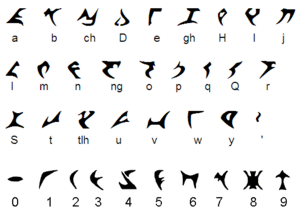Constructed writing system facts for kids
A constructed writing system is a special way of writing that someone or a group of people made up on purpose. It's different from writing systems that grew naturally over a long time, like the alphabet we use for English. Sometimes, these made-up writing systems are for constructed languages (languages that were also made up). Other times, they help scientists study language or are used for practical things in real languages. Good examples are Korean Hangul and the International Phonetic Alphabet.
Contents
What are Constructed Writing Systems?
All writing systems, even ones like Chinese or Arabic script, were created by people. But most writing systems change and grow from older ones over many years. They are not usually designed by one person.
Often, a language starts using another language's writing system. Over time, it slowly adds its own special letters or rules. For example, the letters "w" and "j" were added to the Latin alphabet much later. They became full parts of the English alphabet only in the mid-1800s.
Most people who invent new writing systems already know how to read and write. This means their new script often gets ideas from older ones. So, it can be hard to tell if a new script was just adopted or truly invented. The Cyrillic and Gothic alphabets, for instance, were heavily inspired by the Greek alphabet but were designed by specific people.
In rare cases, a writing system didn't come from an older script. Instead, it grew from very early forms of writing, called proto-writing. This happened with Cuneiform script, Egyptian hieroglyphs, Chinese script, and the Mayan script. But even these systems changed slowly over time. They were not designed all at once.
Why Do People Invent Writing Systems?
For Languages Without Writing
Some writing systems were invented for spoken languages that didn't have a good way to be written down. Examples include Hangul (for Korean), Cherokee, Syllabics, and N'Ko. The origins of the Armenian, Georgian, and Glagolitic alphabets are not fully known, but they might also fit into this group.
For Religious or Spiritual Reasons
Many writing systems are made for religious or spiritual purposes.
- Missionaries or religious scholars might create new scripts to help translate holy books into languages that didn't have a writing system.
- Religious leaders might share new writing systems with their followers. This can be for religious ceremonies or to help build a shared culture. Examples include Sorang Sompeng and Medefaidrin.
- Some scripts are made for mystical uses, like trying to talk to spirits. Examples include the Enochian alphabet, used by John Dee, and the Theban alphabet. Hildegard of Bingen also created a script called litterae ignotae.
- Some creators say their scripts came to them during special spiritual experiences.
For Fictional Worlds

Many constructed scripts are made for languages in fictional stories, movies, or games.
- J. R. R. Tolkien created the detailed Tengwar and Cirth scripts for his fantasy languages.
- The pIqaD script is used for the Klingon language in Star Trek.
- Aurebesh is from Star Wars.
- The D'ni script is from the Myst video games.
- The "Tennobet" script is used in the video game Warframe.
For Technical Uses
Experts in different fields have invented writing systems for technical reasons.
- The International Phonetic Alphabet (IPA) is a very important example. Linguists (people who study language) use it to write down every sound in human language in great detail. It uses some Latin and Greek letters, plus many new symbols.
- Other scripts, like Unifon and Initial Teaching Alphabet, were made to help people learn to read and write.
- Yerkish is a system of visual symbols (lexigrams) made for non-human primates to communicate.
- Shorthand systems are also constructed scripts. They are designed to help people write much faster and easier.
To Change Existing Languages
Some constructed scripts are meant to replace the writing systems we already use.
- In the 1800s, the Church of Jesus Christ of Latter-day Saints promoted the Deseret alphabet. They thought it would be better for writing English sounds.
- Later, the Shavian alphabet was created to do something similar.
- Bradbury Thompson's Alphabet 26 was another project like this.
- Some people have even created entire philosophical or auxiliary languages (languages meant to be used by everyone) with their own writing systems, like aUI and Solresol.
- Blissymbols is a system of symbols meant to be an international language that is written rather than spoken.
Other Special Uses
Some constructed scripts have very unique purposes.
- Ong Kommandam's Khom Script was used for religious reasons and also to hide military messages during a rebellion.
- Braille and other tactile alphabets were invented to help people who are visually impaired read and write by touch.
- Lewis Carroll's Nyctography was for sighted people to write in the dark.
Encoding in Computers
Some constructed scripts have been added to Unicode. Unicode is a system that allows computers to show text from almost all the world's writing systems. The Shavian alphabet and the Deseret alphabet are examples of constructed scripts in Unicode. There is also a special project called the ConScript Unicode Registry that helps coordinate adding many constructed scripts to certain areas of Unicode.
Some of these scripts also have special codes for computer use, like ISO 15924 codes.
See also
 In Spanish: Escritura artificial para niños
In Spanish: Escritura artificial para niños
- List of constructed scripts
- Asemic writing
- Voynich Manuscript
- Fictional alphabet
- Conlang


